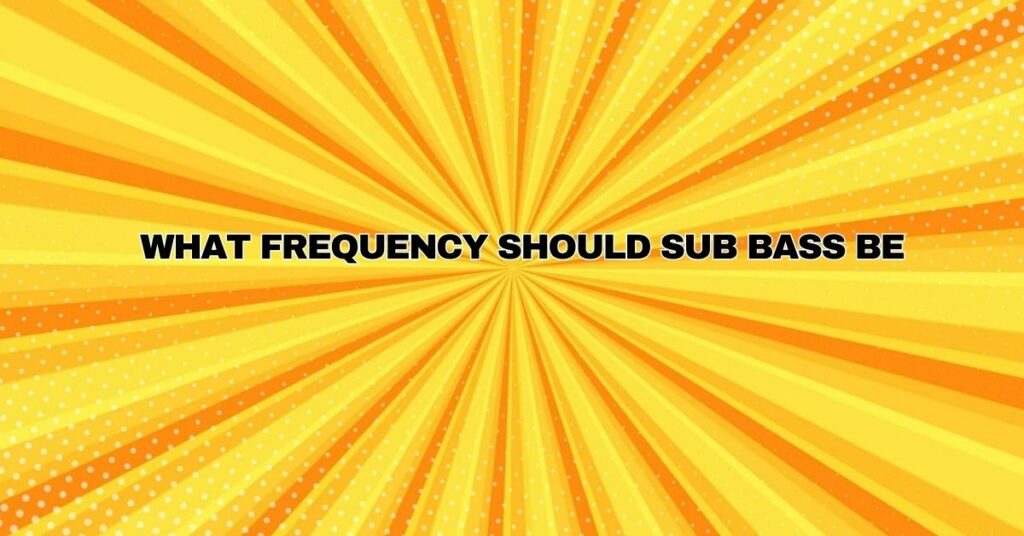Sub-bass frequencies, the foundation of many music genres, have the power to move listeners both emotionally and physically. The choice of the ideal frequency for sub bass is a fundamental decision for musicians, producers, and audio enthusiasts. It’s about creating the deep, resonant low end that can transform a track or an audio system’s performance. In this comprehensive article, we will explore the concept of sub bass, the science behind its frequencies, and how to determine the perfect frequency to achieve a profound and impactful low end.
Understanding Sub Bass
Sub bass, also known as subsonic bass, refers to the ultra-low frequencies that are felt more than they are heard. These frequencies are typically found below 60 Hz and can extend down to 20 Hz. Sub bass provides the physicality and depth in music, making it a crucial element in genres like hip-hop, electronic dance music (EDM), and dubstep. When properly utilized, sub bass can create a visceral experience that resonates with listeners on a deep, emotional level.
The Science of Sub Bass Frequencies
To understand what frequency sub bass should be, it’s essential to delve into the science of sound and human perception. Sub bass frequencies are characterized by their long wavelengths. Lower frequencies have longer wavelengths, and the perception of low-frequency sound is not just a function of hearing but also of feeling.
Here are the key points to consider:
- Wavelengths: Sub bass frequencies, which can extend down to 20 Hz or lower, have incredibly long wavelengths, sometimes measuring several meters. This extended wavelength is a key factor in how sub bass is perceived.
- Physical Impact: The long wavelengths of sub bass allow them to interact with physical objects and structures, creating vibrations. This is why sub bass is often felt in the body and in the environment, such as the pulsating sensation at a live concert.
- Tactile Sensation: Sub bass frequencies create a tactile sensation, where listeners can feel the vibrations and pressure changes rather than just hearing a distinct pitch. This tactile sensation contributes to the emotional and physical impact of sub bass.
Determining the Ideal Sub Bass Frequency
The ideal frequency for sub bass largely depends on the context in which it is used, the genre of music, and the specific artistic intent. Here are some factors to consider:
- Genre and Style: Different music genres have different expectations for sub bass. For example, electronic dance music (EDM) often features sub bass frequencies below 30 Hz, while hip-hop and rap may focus on the 30-60 Hz range. The genre’s characteristic sound can guide the choice of sub bass frequency.
- Listening Environment: The listening environment plays a significant role. In large clubs with powerful subwoofers, sub bass frequencies below 30 Hz are not only audible but physically impactful. In smaller home listening environments, a more balanced approach is often preferred.
- Artistic Intent: The creative vision of the musician or producer is paramount. Some may want to create a raw, intense sound with prominent sub bass, while others may opt for a more controlled mix with a punchy mid-bass. The desired emotional impact and style of the track guide this decision.
- Production Techniques: Production techniques, such as the use of synthesizers and sub-bass modules, influence the choice of sub bass frequency. The characteristics of these tools may limit or extend the available frequency range.
- Audience Preferences: Understanding the preferences of the target audience is essential. Different listeners may have varying expectations and tolerances for sub bass frequencies.
Balancing Sub Bass with Other Elements
In music production, achieving the right balance between sub bass and other elements is critical. Here are some guidelines for balancing sub bass:
- Monitor Quality: High-quality studio monitors or headphones are essential for accurately hearing and adjusting sub bass frequencies.
- Acoustic Treatment: If possible, treat your room acoustics to mitigate standing waves and resonances that can affect your perception of sub bass.
- Reference Tracks: Use professionally mixed and mastered reference tracks to compare your mix and understand how sub bass is balanced in your genre.
- Experimentation: Don’t be afraid to experiment with different sub bass frequencies and listen critically to how they interact with other elements in your mix.
Conclusion
The choice of the ideal sub bass frequency is a multifaceted decision that depends on the genre, artistic intent, listening environment, and audience preferences. Sub bass, with its tactile sensation and emotional impact, is a dynamic element of music that can be both heard and felt. Whether you’re a producer crafting the perfect low end for your track or an audio enthusiast seeking a powerful listening experience, the choice of sub bass frequency plays a vital role in creating a deep, resonant, and memorable sonic experience. Ultimately, it’s about finding the frequency that resonates with the heart and soul of the music and the audience.


